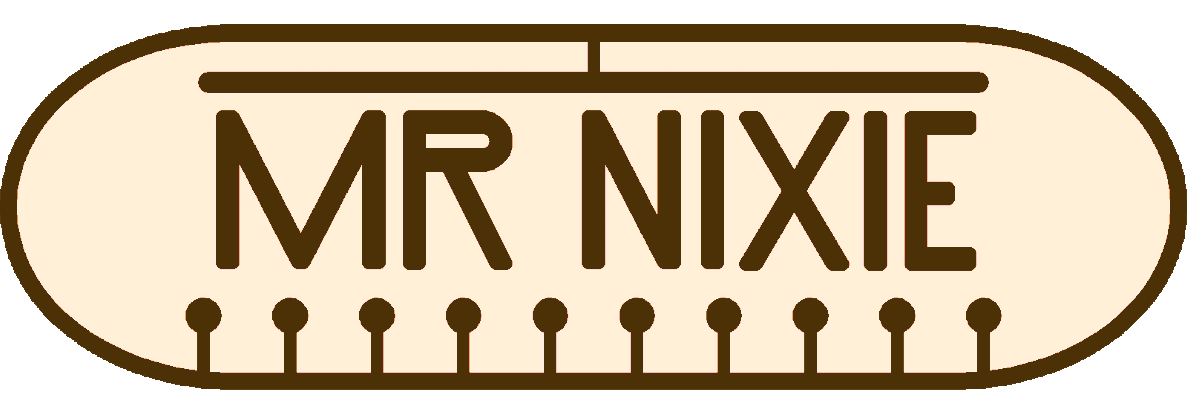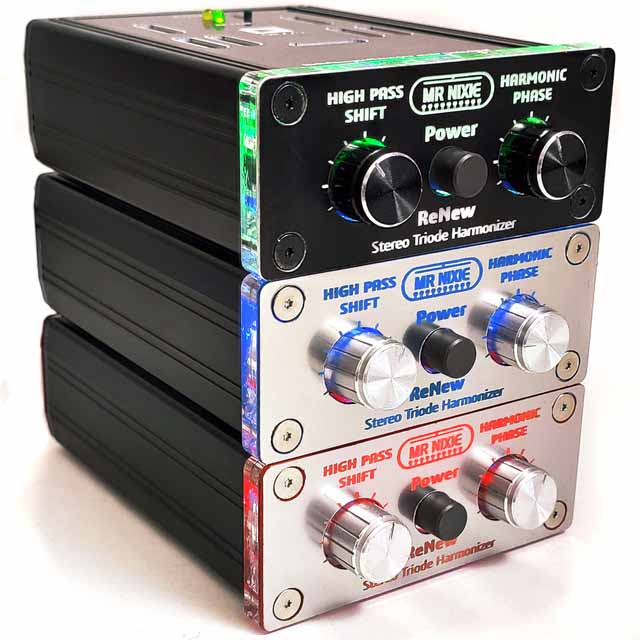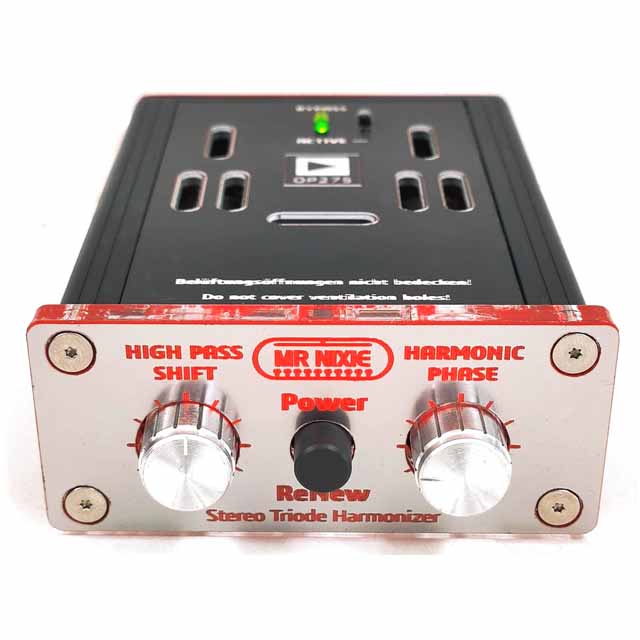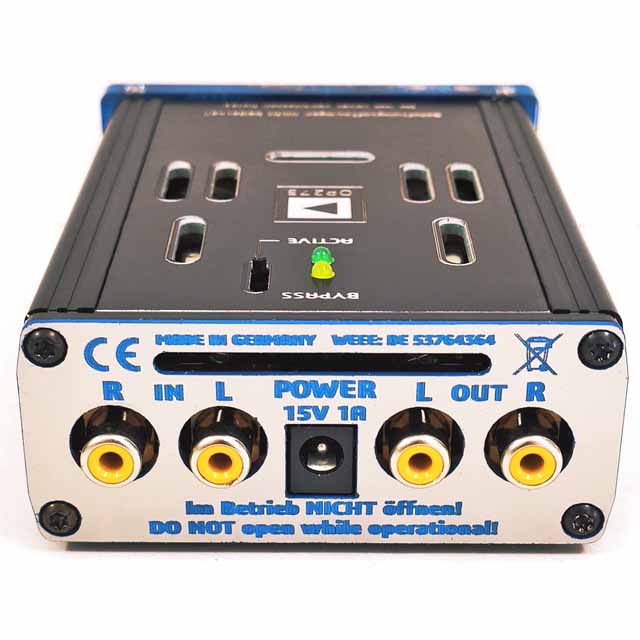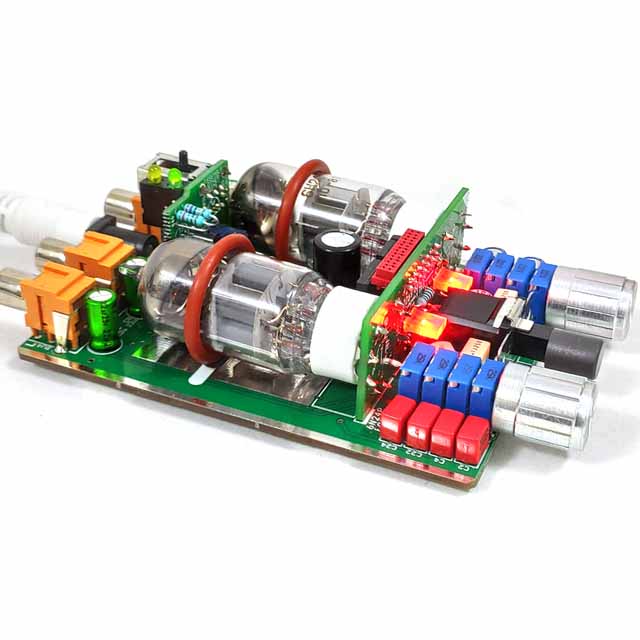Description
The ReNew tube harmonizer generates "pleasing" 2nd harmonic distortion, which phase can continuously adjusted from negative to positive and thus on the one hand "detaches" the sound stage from the speakers; the stage becomes wider and deeper and also the room reverb appears more. On the other hand, you can also make the sound more direct and bring the band, orchestra or even a speaker closer to you. And that without any tonal changes!In addition, an adjustable high-pass filter ensures that the "threshold" of this 2nd harmonic can be shifted from the bass range towards the mid frequencies, so as not to unnaturally "bloat" the bass. A bypass switch allows easy comparison listening.
Ideally, the ReNew is connected to the line output of an audio player, e.g. CD player or streamer.
Please have also a look to:
Basic article from Nelson Pass as PDF download
A discussion about the ReNew in the HiFi and LebensArt forum (German)
Now, unfortunately, we can't avoid using an oscilloscope; please take a close look at the two oscilloscope images of the ReNew Harmonizer.
The die-hard tube fan will surely recognize one or the other optic of the sine wave.
Good to know:
The ReNew does not simply invert the entire signal to obtain a inverted phase; it inverts only the adjustable 2nd harmonics. Also on normal use the signal doesn't look as awfull as on the screenshots. This only happens when the ReNew is driven by generator (for the screenshot) into its absolute limits.

Talking of positive phase is when the negative half-wave is flattened, and talking of negative phase is when the positive half-wave is flattened.
Or the other way round: On positive phase, the positive half-wave remains virtually untouched, and on negative phase, the negative half-wave looks untouched.
But in which way is the signal modified by the H2 harmonics?
For this answer we need a "more detailed" oscilloscope image of a negative H2 phase when setting the "Harmonic Phase" potentiometer anti clockwise
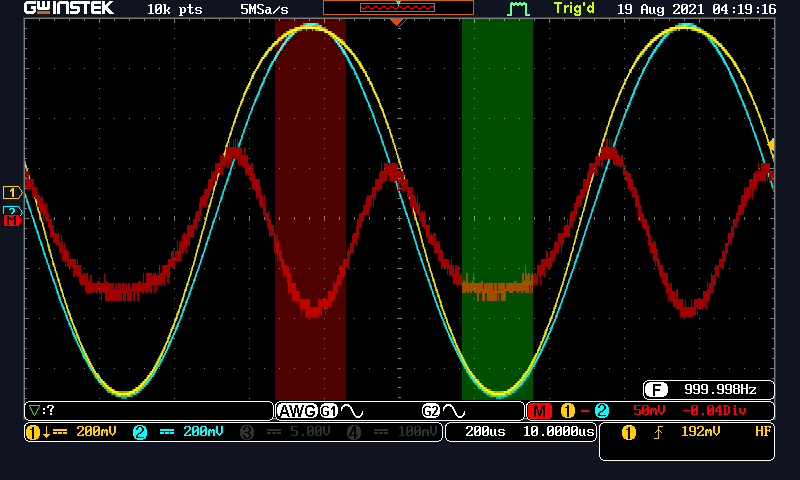
In this screenshot the cyan curve is the 1 kHz output signal of the sine wave generator.
he yellow signal is the output signal of the ReNew with the "Harmonic Phase" pot set to 9 o'clock
The red signal is the mathematically difference between these two signals; the 1 kHz sine wave is subtracted and the distortions of the ReNew remains.
As you can see in the red marked area, the sine signal of the ReNew is flattened "at the top" in the positive area at the peak and this is, because in
this moment the 2nd harmonic has its peak in the negative area and therefore it "nibbles off" a small amount of the positive voltage, so to speak.
Imagine a battery set with 8 x 1,5 V batteries. If all are inserted correctly, we get 12 V. If we now reverse the polarity of one cell,
we still have 7 x 1,5 V = 10,5 V plus the incorrectly inserted cell, which "nibbles off" 1,5 V, so finally 9 V remain. This is the principle.
.
In the green area both, the ReNew signal (yellow) and the 2nd harmonic are negative. In this case the output signal would be even a little bit louder.
If you set the zero line on the left of the display (marked with a yellow "1") onto the level of the cyan colored 2nd harmonic baseline
(the output signal from the sine oscillator);
you could even see this - if it would fit on the display.
By the way, the red 2nd harmonics are amplified 4 times compared to the fundamental for clearer display.
And it also works "the other way round" with a positive phase - here the "Harmonic Phase" potentiometer is set between 1 and 2 o'clock -
and this is also the setting preferred by the test listeners: The sound becomes more spatial and also "brushed up" a little bit in the trebles.
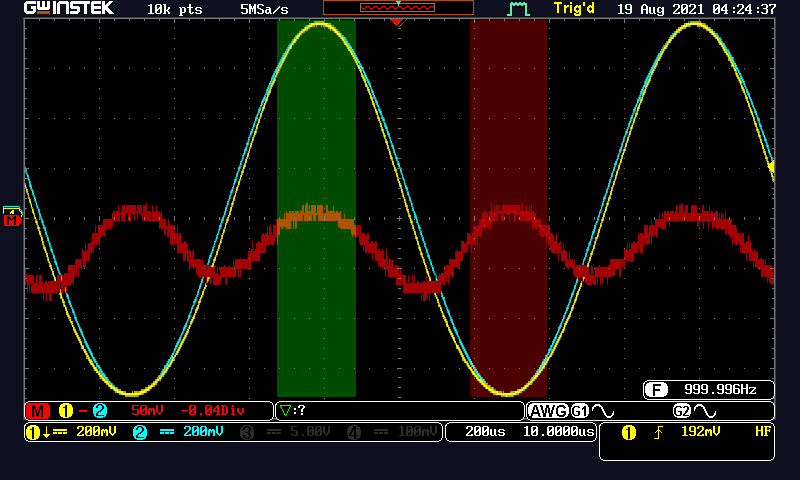
As already mentioned, the ReNew preferes line level to work correctly; that means it should be connected to the line output of a "semiconductor" player, e.g. CD player, streamer, web radio or a good semiconductor phono preamplifier. Just everywhere where you would like to give the sterile sound of the semiconductors a little more pleasing:
And - in contrast to tube preamps - where the amount of this harmonic distortions are fixed - with the ReNew you now have the ingenious possibility to adjust them continuously according to your personal taste.
Also for the reason, as tube preamps already creates H2 harmonic distortions, I see the additional treatment of the signal by the ReNew rather critical, so to say "too much medicine".
Furthermore, inserting in the audio path between preamp and power amp is not recommended, because usually the volume level is set in the preamp and the power amp only gets line level when the walls will shake. At normal listening volume on much lower level you will hardly hear any effect.
Unless you have a pure passive audio source selector and the volume is adjusted at the power amp. This will works perfectly, of course.
But it is still something else, if your "normal" preamp has a tape in-/output and additionally a tape monitor switch for tape read after write listening. This will work, because the "To-Tape connection" gets line level before the volume control. The ReNew is connected like a tape recorder, so to speak. Connect the "To-Tape" (or REC) rail from the amp to the ReNew's input and the ReNew's output to the "From Tape" (or PLAY) plugs. Now you just have to press the Tape-Monitor button and can listen to the ReNew's signal on your speakers.
Features
- Developed and handcrafted in Germany in small quantities
- Equipped with: High temperature LowESR-, Nichicon Muse bipolar-, Polymer electrolytic capacitors, 5% Metallfoil and 1% WIMA Polypropylene capacitors
- Frequency response: 25 Hz ... 150 kHz (-3 dB)
- Input: Stereo RCA jacks for line level (from -10 dBV)
- Input impedance: 4 kOhm min. for semiconductor outputs of audio players
- Output: Stereo RCA jacks with line level
- Output impedance: 75 ohms
- Output driver: Analog Device OP275 "Buttler" FET operational amplifier with subsonic filter
- H2 Phase: Steppless adjustable from negative to positive
- High pass filter for H2 harmonics: Stepples adjustable from linear to 4 kHz
- DC input: 15 V (5.5/2.1 mm jack) - Universal power supply is included
- Switch on duration: Can be turned on indefinitely by about 9 watts power consumption
- Valve line-up: 6N24P (NOS) or JJ E88CC (RoHS). The tube board can be connected the way round for adpoting the different socket connections of these two types of tubes.
- LED display: green for Active, yellow for Bypass, colour selectable LED front frame illumination
- Controls: Push button for On/Off, control knobs for High Pass an Harmonic Phase, Slider for Aktiv / Bypass
- Bypass via encapsulated signal relay, so even if the ReNew is switched off, the input signal is linked to the output
- Dimensions: 125 x 85 x 36 mm
- Weight: 300 g
Order
Fully assembled and tested Harmonizer incl. switching power supply.
Personal and professional advice from the manufacturer is our permission.
Therefore, please contact us via email before placing an order so that we can offer exactly the component that is tailored to your needs.Shipping costs
Flat shipping costs within Germany of 9.50 EUR are added per order; shipping to "DHL-Packstation" is possible.
The prices of the DE / EU versions includes the German VAT.
Especially when shipping abroad, different shipping costs are incurred during the Corona crisis or we are convenanted to certain shipping service providers. Unfortunately, this has to be clarified manually in advance.
Handling fees
Higher handling costs for export are already included in the item price exept of import duties, taxes etc. These charges are the buyer's responsibility.
